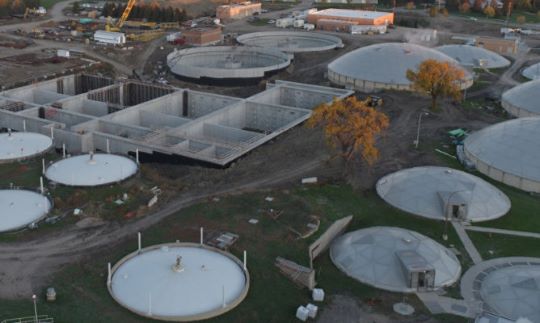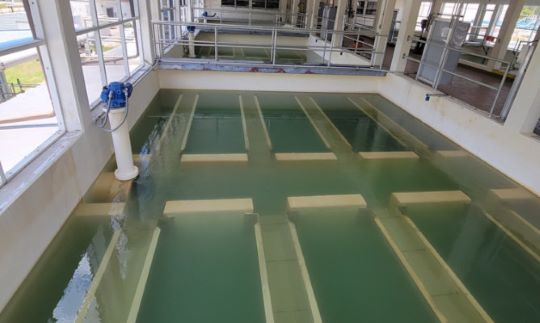Sherwin-Williams (Cleveland, Ohio, USA) recently announced top honors in the 2023 Sherwin-Williams Impact Awards program. Each year, the program recognizes exceptional projects featuring the manufacturer’s high-performance coating and lining materials.
This year, first place went to an ambitious $124-million renovation and expansion of a large-scale water reclamation facility in Fargo, North Dakota. According to the manufacturer, this project involved continuous collaboration between applicators and engineers.
The Fargo project featured a multi-year expansion of the Fargo Regional Water Reclamation Facility’s capacity to more than 100 million gallons (378,541 m3) per day, all while showcasing the critical importance of meticulous planning, teamwork and advanced coating technologies to improve operational efficiency and asset integrity.
This facility is owned and operated by the city. PKG Contracting Inc. led the overall project, with Protech Contracting Services Inc. serving as the applicator.
Meanwhile, the runner-up project for the 2023 awards went to a challenging refurbishment of six aging basins at the Ralph Brennan Water Treatment Plant in Daytona Beach, Florida.
Carried out by applicator Exceletech Coating and Applications LLC and general contractor PC Construction, the project involved complex methods to remove obsolete coatings, advanced techniques for concrete repair and high-performance coatings to improve structural durability without interrupting service to the city’s 70,000 residents.
“We take great pride in presenting these outstanding examples of how our coating technologies—rooted in modern and efficient methods focused on sustainability—can help make clean water more accessible and improve how wastewater is processed,” says Paul Trautmann, marketing director for water and wastewater at Sherwin-Williams Protective & Marine.
“We use the Sherwin-Williams Impact Awards to celebrate the incredible work and dedication of project teams across the country whose creativity and hard work ensure vital infrastructure stands the test of time,” Trautmann adds.
Each year, the Impact Awards celebrate contractors, specifiers, and asset owners for outstanding performance on water and wastewater projects across North America.
These honors recognize projects that significantly influence the industry by protecting assets, improving their lifecycles, and enhancing safety. Eligible submissions included any water-related structures that were new, renovated, or rehabilitated in 2023, so long as they utilized coating and lining materials from Sherwin-Williams Protective & Marine.
Fargo Regional Water Reclamation Facility
In Fargo, the city’s water reclamation facility underwent a significant overhaul. This project not only upgraded existing structures but also integrated new facilities, all while demonstrating a major investment in the growing city’s infrastructure and reinforcing its commitment to environmental sustainability.
The three-year project called for substantial structural work, including a significant amount of structural concrete for new and existing facilities such as a large-scale integrated fixed-film activated sludge (IFAS) building and others. The project also featured many large-scale excavations; extensive piping to support an expanded headworks facility; and the installation of non-slip resinous flooring for safety.
Though the project’s coating portions were originally specified for another manufacturer’s products, Protech Contracting Services Inc.—subcontractor and applicator—transitioned to Sherwin-Williams coatings for their compatibility and ready availability, which was crucial for adhering to project timelines and minimizing disruptions.
The complex coating sequence, influenced by project scheduling and available spaces, required close collaboration with the general contractor. Challenges included coordinating multiple trades, adhering to tight schedules, adapting to shifting priorities and weather, and applying coatings without disrupting plant operations.

The project involved coating diverse surfaces such as concrete structures, piping, equipment, walls, and floors. Application techniques varied between spraying and hand-rolling, depending on the surface and complexity, with high-pressure airless sprayers used for larger areas and hand-rolling for complex piping systems and confined spaces.
To enhance non-slip properties on floors, the project team used broadcasting and back-rolling techniques, and they incorporated sand in both the mid-coat and topcoat. This approach ensured the coatings provided a robust, safe surface suitable for harsh environments, easy cleaning, and chemical resistance.
In the new IFAS facility, Protech’s applicators coated the top 7 feet (2.1 m) of the aerobic tanks—which are exposed to gases—with Dura-Plate 2300 as a mortar base and Dura-Plate 6000 as a topcoat. This dual-layer approach ensured robust protection against chemical exposure. Applicators also treated the return activated sludge splitter box and IFAS splitter box with Dura-Plate 6000 over a Dura-Plate 2300 base to provide protection from environmental factors.
The crew applied Dura-Plate 2300 using a mortar sprayer and manually leveled the material for a smooth finish. Subsequently, they sprayed Dura-Plate 6000 using a high-pressure sprayer, providing a strong protective layer. For smaller structures like manholes and areas unsuitable for spraying, crew members applied coatings manually, which reduced the need for containment and cleanup.
In addition, applicators coated the wet well in the implant waste pump station—along with the valve vault and several manholes—with Dura-Plate 6000. This product was chosen for its ability to withstand harsh conditions.
For concrete exposed to hydrogen sulfide gases and chemicals, Protech used a multi-layer coating system. The system was comprised of a primer; Sher-Glass FF, a glass flake reinforced epoxy, as a mid-coat; and a urethane topcoat for visible areas.
For general piping not exposed to gases, the contractor used the Macropoxy 646 epoxy and finished with a urethane topcoat, which ensured comprehensive protection against corrosion and chemical exposure. Prior to the application, Protech blasted new and existing concrete surfaces to create a suitable profile for proper coating adhesion.
For topcoats of external surfaces exposed to ultraviolet (UV) light—including on some motors and outdoor equipment—the project team chose Hi-Solids Polyurethane 250 based on the product’s enhanced durability. Designed for high-performance protection with outstanding exterior gloss and color retention, this coating serves as a heavy-duty maintenance layer.
For various metal and fiberglass surfaces, such as tanks and ducting, applicators utilized the Corothane Mio-Zinc Primer to prevent corrosion; Macropoxy 646 as the primary protective layer; and Acrolon Ultra as a topcoat for UV and environmental protection. The topcoat also served as an aesthetic enhancement, especially on exterior surfaces.
Protech added anti-graffiti coatings to publicly accessible areas to prevent vandalism, including exterior surfaces of final clarifiers.
Throughout the project, Sherwin-Williams says it provided technical support to Protech to ensure the correct application of products. This support included on-site assistance and guidance on product specifications and application techniques.
Completed this spring, the Fargo project was notable for featuring effective coordination, optimal product selection, and skilled application techniques, according to the manufacturer.
“By enhancing the plant’s capacity and operational resilience, the city of Fargo has taken a significant step toward securing its environmental and public health future,” the coating manufacturer says in its announcement. “It has also set a new benchmark for future infrastructure projects in the region.”
Daytona Beach Honorable Mention
Serving around 70,000 residents, the Ralph Brennan plant in Daytona Beach, Florida, recently underwent a $6.6-million refurbishment to revitalize six aging basins while replacing an obsolete Leopold filter underdrain system.
This project required cutting-edge methods to strip away decades-old coatings; repair and resurface concrete; and apply advanced high-performance linings. The project team’s careful planning, execution, and attention to detail earned runner-up honors in the 2023 Impact Awards.
These upgrades were accomplished without disrupting the treatment plant’s operations, thereby ensuring a continuous supply of safe and reliable water. The project restored the plant’s critical systems while significantly boosting its capacity to serve the local community for years to come.
Executed by Exceletech Coating and Applications LLC—a Central Florida-based applicator of industrial and commercial coatings and high-performance linings—along with general contractor PC Construction, the 18-month project required a detailed and methodical approach to surface preparation. Three of the basins featured coatings from the late 1970s to early 1980s, while the others were coated in the early 2000s. This presented distinct challenges due to the varying thickness and deterioration of existing coatings and surfaces.

The three older basins, coated with a thick epoxy system of up to 125 mils (3,175 microns), demanded rigorous removal efforts. The project team employed a combination of saw-cutting keyway lines plus pneumatic chipping and scraping to strip the coatings down to the bare concrete. Following this, crew members used a 5,000-psi (34.5 MPa) pressure wash and an abrasive blast with coal slag to create a suitable surface profile for new coatings.
In contrast, the three newer basins with thinner 20-to-30 mil (508-to-762 micron) coatings required only abrasive blasting to remove the existing layers. Subsequent surface grinding leveled high areas, with deeper patching performed where rebar was exposed. Applicators meticulously applied a cementitious resurfacing material, Dura Plate 2300, by hand to an average thickness of 3/16 inch (4.8 mm), which provided a robust foundation for the final coatings.
Next, Exceletech applied the Macropoxy 5500 in multiple coats to achieve a final thickness of approximately 20 mils. The application process involved careful brush-and roll-techniques to ensure comprehensive coverage and long-term durability.
For the concrete surfaces, which were prone to moisture issues, applicators used a catalyzed water-based epoxy, Pro Industrial. According to the manufacturer, this solution was chosen for its moisture resistance and breathability. Crew members applied this coating using an airless spray and back-rolling technique to achieve a uniform finish.
Beyond surface preparation and coating, the project included significant mechanical and structural enhancements. In the pipe gallery, extensive corrosion was addressed using a 5,000-psi rotator tip pressure wash and electric bristle blasters for detailed work.
Applicators spot-primed corroded areas with Macropoxy 920 before applying two coats of Macropoxy 646 and a final layer of Acrolon 218. To prevent future corrosion, all mounting hardware was replaced with stainless steel.
To maintain uninterrupted operation of the plant, the project team carefully staged the refurbishment and allowed only one basin to be taken offline at a time. Exceletech constructed full enclosures around each affected basin to prevent contamination of the operational filters, and daily inspections ensured the integrity and cleanliness of these enclosures.
The project required over 45 individual shutdowns, which necessitated precise coordination with the general contractor, PC Construction. Exceletech also worked closely with plant operators to understand their operational needs, facilitating swift and efficient shutdowns to minimize any impact on the plant’s capacity.
Completed in September 2023, the upgrades were essential to meeting the plant’s permitted capacity of 24 million gallons (90,850 m3) per day. Going forward, officials expect this to extend the useful life of the facilities while securing water supply for Daytona Beach residents.
Source: Sherwin-Williams Protective & Marine, industrial.sherwin-williams.com/na/us/en/protective-marine.